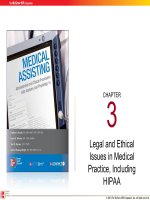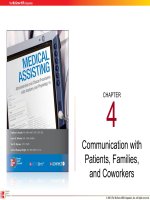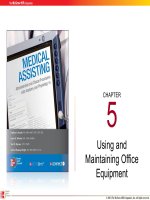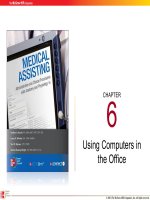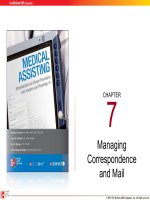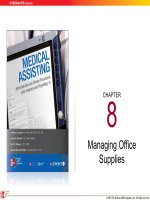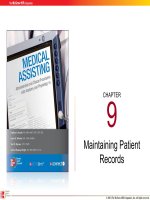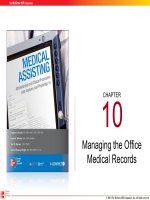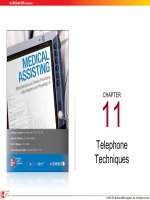Lecture Medical assisting: Administrative and clinical procedures with anatomy and physiology (4e) – Chapter 22
Bạn đang xem bản rút gọn của tài liệu. Xem và tải ngay bản đầy đủ của tài liệu tại đây (1.43 MB, 67 trang )
CHAPTER
22
The Muscular
System
© 2011 The McGraw -Hill Com panies, Inc. A ll rights reserv e d.
22-2
Learning Outcomes
22.1 List the functions of muscle.
22.2 List the three types of muscle tissue and
describe the locations and characteristics of
each.
22.3 Describe how visceral (smooth) muscle
produces peristalsis.
22.4 Explain how muscle tissue generates
energy.
© 2011 The McGraw -Hill Com panies, Inc. A ll rights reserv e d.
22-3
Learning Outcomes (cont.)
22.5 Describe the structure of a skeletal muscle.
22.6 Define the terms origin and insertion.
22.7 List and define the various types of body
movements produced by skeletal muscles.
22.8 List and identify the major skeletal muscles
of the body, giving the action of each.
© 2011 The McGraw -Hill Com panies, Inc. A ll rights reserv e d.
22-4
Learning Outcomes (cont.)
22.9 Explain the differences between strain and
sprain injuries.
22.10 Describe the changes that occur to the
muscular system as a person ages.
22.11 Describe the causes, signs and symptoms,
and treatments of various diseases and
disorders of the muscular system.
© 2011 The McGraw -Hill Com panies, Inc. A ll rights reserv e d.
22-5
Introduction
•
Bones and joints do
not produce
movement
•
The human body has
more than 600
individual muscles
•
Muscles cause bones
and supported
structures to move by
alternating between
contraction and
relaxation
You will focus on the differences among three muscle tissue
types, the structure of skeletal muscles, muscle actions, and
the names of skeletal muscles.
© 2011 The McGraw -Hill Com panies, Inc. A ll rights reserv e d.
22-6
Functions of Muscle
Muscle has the ability
to contract, permitting
muscles to perform
various functions
• Functions:
– Movement
– Stability
– Control of body
openings and
passages
– Heat production
Click for
Larger View
© 2011 The McGraw -Hill Com panies, Inc. A ll rights reserv e d.
22-8
Movement
•
Skeletal muscles
– Attached to bones by tendons
– Cross joints so when they contract, bones they attach
to move
•
Smooth muscle
– Found on organ walls
– Contractions produce movement of organ contents
•
Cardiac muscle
– Produces atrial and ventricular contractions
– This pumps blood from the heart into the blood
vessels
© 2011 The McGraw -Hill Com panies, Inc. A ll rights reserv e d.
22-9
Stability
•
Hold bones tightly together
– Stabilize joints
•
Small muscles hold vertebrae
together
– Stabilize the spinal column
© 2011 The McGraw -Hill Com panies, Inc. A ll rights reserv e d.
22-10
Control of Body Openings and Passages
•
Sphincters
– Valve-like structures formed by muscles
– Control movement of substances in and
out of passages
– Example:
•
A urethral sphincter prevents or allows
urination
© 2011 The McGraw -Hill Com panies, Inc. A ll rights reserv e d.
22-11
Heat Production
•
Heat is released with
muscle contraction
– Helps the body maintain a
normal temperature
– Moving your body can
make you warmer if you
are cold
© 2011 The McGraw -Hill Com panies, Inc. A ll rights reserv e d.
22-12
Apply Your Knowledge
True or False:
ANSWER:
tendons
___
F Skeletal muscles are attached to bones by ligaments.
T Contractions of smooth muscle produce movement of
___
organ contents.
T Cardiac muscle produces atrial and ventricular
___
contractions.
in and out
F Sphincters control movement of substances out of
___
passages.
F Heat is released as muscles relax.
___
contract
© 2011 The McGraw -Hill Com panies, Inc. A ll rights reserv e d.
22-13
Types of Muscle Tissue
• Muscle cells
– Myocytes called muscle
fibers
– Sarcolemma – cell membrane
– Sarcoplasm – cytoplasm of
cell
– Myofibrils – long structures in
sarcoplasm
• Arrangement of filaments in
myofibrils produces striations
© 2011 The McGraw -Hill Com panies, Inc. A ll rights reserv e d.
22-14
Types of Muscle Tissue (cont.)
Muscle
Group
Major
Location
Skeletal
Muscle
Attached to
bones and skin of
the face
Produces body
movements and
facial expressions
Voluntary
Smooth
Muscle
Walls of hollow
organs, blood
vessels, and iris
Moves contents
through organs;
vasoconstriction
Involuntary
Cardiac
Muscle
Wall of the heart
Pumps blood
through heart
Involuntary
Major
Function
Mode of
Control
© 2011 The McGraw -Hill Com panies, Inc. A ll rights reserv e d.
22-15
Skeletal Muscle
• Muscle fibers respond to the
neurotransmitter acetylcholine
– Causes skeletal muscle to contract
• Following contraction, muscles release the
enzyme acetylcholinesterase
– Breaks down acetylcholine
– Allows muscle to relax
© 2011 The McGraw -Hill Com panies, Inc. A ll rights reserv e d.
22-16
Smooth Muscle
• Multiunit smooth muscle
– In the iris of the eye and walls of blood
vessels
– Responds to neurotransmitters and hormones
• Visceral smooth muscle
– In walls of hollow organs
– Responds to neurotransmitters AND
– Stimulate each other to contract so that
muscle fibers contract and relax together in a
rhythmic motion – peristalsis
© 2011 The McGraw -Hill Com panies, Inc. A ll rights reserv e d.
22-17
Smooth Muscle (cont.)
•
Peristalsis – rhythmic contraction
that pushes substances through
tubes of the body
•
Neurotransmitters for smooth muscle
contraction
– Acetylcholine
– Norepinephrine
– Will cause or inhibit contractions,
depending on smooth muscle type
© 2011 The McGraw -Hill Com panies, Inc. A ll rights reserv e d.
22-18
Cardiac Muscle
• Intercalated discs
– Connect groups of cardiac
muscle
– Allow the fibers in the groups to
contract and relax together
• Allows heart to work as a pump
• Self-exciting – does not need
nerve stimulation to contract
– Nerves speed up or slow down
contraction
© 2011 The McGraw -Hill Com panies, Inc. A ll rights reserv e d.
22-19
Cardiac Muscle (cont.)
• Neurotransmitters
– Acetylcholine – slows
heart rate
– Norepinephrine –
speeds up rate
© 2011 The McGraw -Hill Com panies, Inc. A ll rights reserv e d.
22-20
Apply Your Knowledge
Match the following:
ANSWER:
C Self-exciting
___
A Contract in response to
___
acetylcholine
B Stimulate each other to
___
contract
B Peristalsis
___
C Slowed by acetylcholine
___
A Voluntary movement
___
A. Skeletal muscle
B. Smooth muscle
C. Cardiac muscle
Very
Good!
© 2011 The McGraw -Hill Com panies, Inc. A ll rights reserv e d.
22-21
Production of Energy for Muscle
• ATP (adenosine
triphosphate)
– A type of chemical
energy
– Needed for
sustained or
repeated muscle
contractions
•
Muscle cells must
have three ways to
store or make ATP
– Creatine phosphate
•
Rapid production of
energy
– Aerobic respiration
•
Uses body’s store of
glucose
– Lactic acid production
•
Small amounts of ATP
© 2011 The McGraw -Hill Com panies, Inc. A ll rights reserv e d.
22-22
Oxygen Debt
•
Develops when skeletal muscles are used
strenuously for several minutes and cells are
low in oxygen
Pyruvic acid
Converts
to
To liver for conversion to
glucose, requiring more
energy and oxygen to make
ATP
Lactic acid
which builds up
Muscle fatigue
Oxygen debt
© 2011 The McGraw -Hill Com panies, Inc. A ll rights reserv e d.
22-23
Muscle Fatigue
•
•
Condition in which a muscle has lost its
ability to contract
Causes
– Accumulation of lactic acid
– Interruption of the blood supply to a muscle
– A motor neuron loses its ability to release
acetylcholine onto muscle fibers
© 2011 The McGraw -Hill Com panies, Inc. A ll rights reserv e d.
22-24
Apply Your Knowledge
Match the following:
ANSWER:
E Rapid production of energy
___
C Needed for sustained or
___
repeated muscle contractions
D Uses body’s store of glucose
___
A Muscle fatigue
___
B With strenuous exercise,
___
converts to lactic acid
A. Lactic acid
B. Pyruvic acid
C. ATP
D. Aerobic
respiration
E. Creatine
phosphate
Yippee!
© 2011 The McGraw -Hill Com panies, Inc. A ll rights reserv e d.
22-25
Structure of Skeletal Muscles
•
Skeletal muscles
– The major components of the
muscular system
•
Composition
– Connective tissue
– Skeletal muscle tissue
– Blood vessels
– Nerves
© 2011 The McGraw -Hill Com panies, Inc. A ll rights reserv e d.
22-26
Connective Tissue Coverings
•
Fascia
– Covers entire skeletal
muscles
– Separates them from
each other
•
Tendon
•
Aponeurosis
– A tough, sheet-like
structure made of
fibrous connective
tissue
– Attaches muscles to
other muscles
– A tough, cord-like
structure made of
fibrous connective
tissue
– Connects muscles to
bones
© 2011 The McGraw -Hill Com panies, Inc. A ll rights reserv e d.

